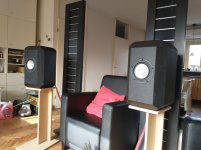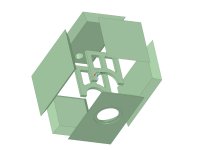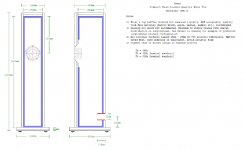Flipping the above to make an iBIB, and adding 4” to the bottom (have to do some actual math to see if that is right), one lowers the driver 8”
dave
dave
I wanted to build one of the examples from the original datasheet, the Pactolus. It is designed in 18 mm MDF. As an experiment I did build a extra strong version. I used 38 mm MDF and managed to ad two struts (is this the right word ?) After glueing it al together I chamfered all corners at 45 degrees (50 x 50 mm). I'm listening now for a month and I'm surprised by the sound quality.
An externally hosted image should be here but it was not working when we last tested it.
An externally hosted image should be here but it was not working when we last tested it.
Nice job. 🙂 You'll have slightly different baffle loading from what I designed, but the large chamfers will likely balance off the changed step F3, so all good.
'Struts' = braces, or they do if they're what I assume you mean.
'Struts' = braces, or they do if they're what I assume you mean.
Here is what I made to reinforce the construction :
An externally hosted image should be here but it was not working when we last tested it.
I wanted to build one of the examples from the original datasheet, the Pactolus.]
Your pictures are behind your google log-in. Best to attach them to the forum.
dave

diyAudio moderation team
I wanted to build one of the examples from the original datasheet, the Pactolus
Which of the reflexes is it, i have to do proper drawings of those.
Braces should be oriented such that the subpanels created by the brace should have higher (and different from each other) than the panel they are bracing.
Given that general rule your braces should be vertical not horizontal, a cross if the box is large enuff. Avoid a solid panel parallel to the baffle behind the driver.
Note that quality 15m mplywood will handily outperform 18m mMDF, and 25m better than 38m MDF. With proper bracing, 18m play should smoke the 38mm MDF. MDF is a poor material for building loudspeakers.
dave
I'm not able to edit my messages.Your pictures are behind your google log-in. Best to attach them to the forum.
dave
diyAudio moderation team
Dave, and anyone else interested, I have not gone away or forgotten this thread. When Dave asked me about the alternate Zd, I gave him a bad answer and later remembered vaguely a discussion in the BIB thread about 2 possible Zd measurements. So I have been trying to find the two percentage points on the line length which work. I am somewhere in 2006 re-reading the thread trying to find it. I'll be back when I've found the info on the tapping points. Thanks.
Ken
Ken
Second try :
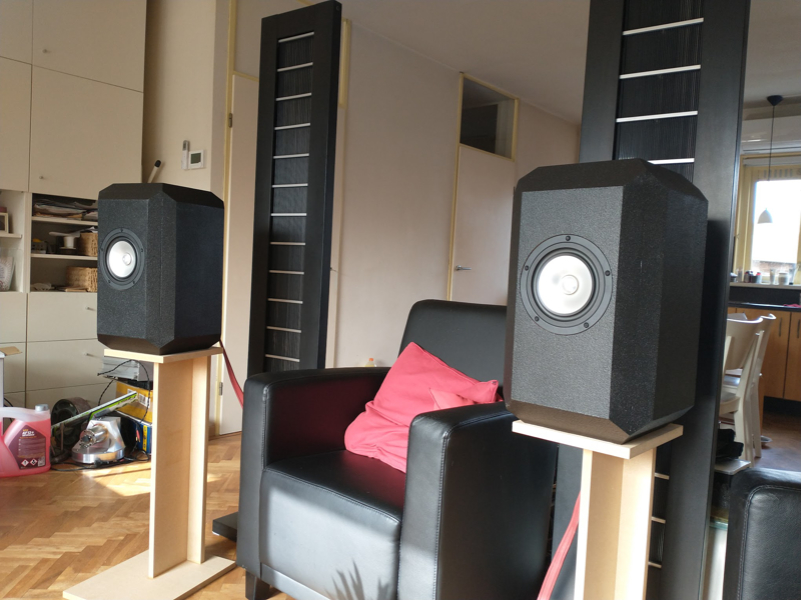
Exploded view.
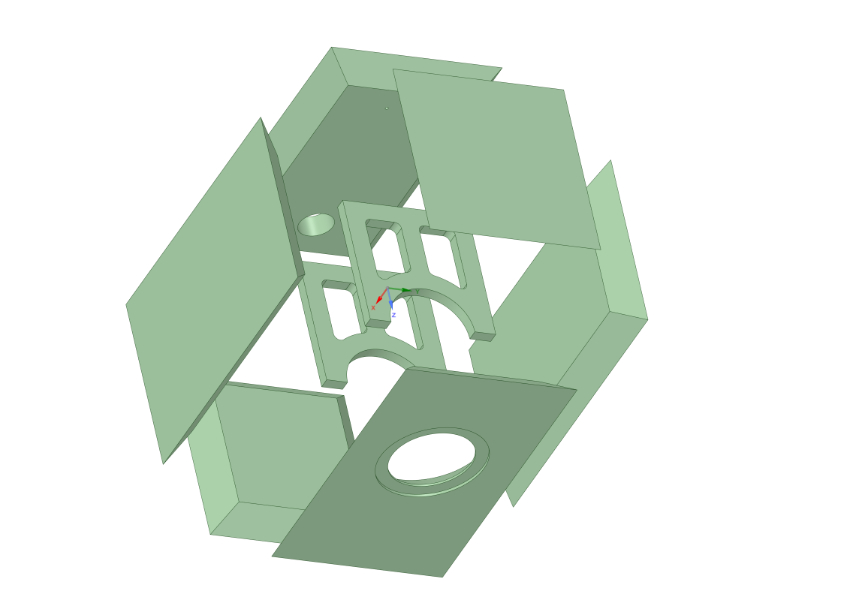
Exploded view.
Attachments
Last edited by a moderator:
@rienkleinjan
What amplifier do you use?
I wonder if a transistor amplifier would suit to this speaker. I see quoted in the specs that this enclosure is suited to "voltage-high damping factor-amplifiers".
A friend of mine wants to build it as a first-time attempt and he has an Arcam Delta 290.
What amplifier do you use?
I wonder if a transistor amplifier would suit to this speaker. I see quoted in the specs that this enclosure is suited to "voltage-high damping factor-amplifiers".
A friend of mine wants to build it as a first-time attempt and he has an Arcam Delta 290.
@rienkleinjan
What amplifier do you use?
I wonder if a transistor amplifier would suit to this speaker. I see quoted in the specs that this enclosure is suited to "voltage-high damping factor-amplifiers".
A friend of mine wants to build it as a first-time attempt and he has an Arcam Delta 290.
I am using a low budget tube amplifier : Audioromy 828 / FU 29.
I ran mine from a bunch of amps, going from a 32w Prima Luna Prologue 4 (class AB1) tube amp with EL34 tubes (which sounds the best), a Marantz PM5004 (class AB transistor) which is very good and a cheap chinese class D SMSL SA36, which still sound more than decent but less good than the two others. This driver is not that amp-picky, as the differences are reasonable small. But tubes sound better to my ears.
Gentleman,
I am new to the forum and to speaker building. I have very few tools and even less skill with which to build a cabinet.
Would it be possible to use the CHN110 with the following cabinet?
Denovo Audio Knock-Down MDF 0.56 cu. ft. Bookshelf Speaker Cabinet
What would the recommended port length be? I was thinking 4.75".
Can the port be put on the front of the cabinet?
Why is it recommended to avoid acoustic foam for sound deadening?
I intend to use the speakers as nearfield monitors on my desk.
Thanks in advance for your assistance.
I am new to the forum and to speaker building. I have very few tools and even less skill with which to build a cabinet.
Would it be possible to use the CHN110 with the following cabinet?
Denovo Audio Knock-Down MDF 0.56 cu. ft. Bookshelf Speaker Cabinet
What would the recommended port length be? I was thinking 4.75".
Can the port be put on the front of the cabinet?
Why is it recommended to avoid acoustic foam for sound deadening?
I intend to use the speakers as nearfield monitors on my desk.
Thanks in advance for your assistance.
Gentleman,
I am new to the forum and to speaker building. I have very few tools and even less skill with which to build a cabinet.
Would it be possible to use the CHN110 with the following cabinet?
Denovo Audio Knock-Down MDF 0.56 cu. ft. Bookshelf Speaker Cabinet
What would the recommended port length be? I was thinking 4.75".
Can the port be put on the front of the cabinet?
Why is it recommended to avoid acoustic foam for sound deadening?
I intend to use the speakers as nearfield monitors on my desk.
Thanks in advance for your assistance.
No, that is way to small for this. It need double that size. And better find a woodworker to do the wood if you can't than to use this driver in a non-fitting cabinet. Port length depends on the volume and the specs of the driver and the tuning frequency, so no prefab number. There is an aperiodic tuned plan for this driver altough that is small, but it's 18L (0.64cuft), not 0.56cuft) and that works only with high impendance output amps.
If you need a small cabinet, there are better Mark Audio drivers (10.3 or 11MS). And if you need studio monitors, there are better speakers like the Overnight Sensation kit (also on parts express) that are neutral in sound and come with a prefab cabinet that is tuned to it.
Overnight Sensations MT Speaker Kit Pair
Would it be possible to use the CHN110 with the following cabinet?
It could be made to work, but about twice as big is closer to optimal.
It also looks to be a poorly designed box (brace ryns the wrong way) and MDF (not good speaker building material IMO).
Contact Bob Berner, he could probably do you a proper flat-pak. I expect that the box he has in his library for the SEAS A26 could be tweaked to work ewith the CHN110.
dave
No, that is way to small for this. It need double that size. And better find a woodworker to do the wood if you can't than to use this driver in a non-fitting cabinet. Port length depends on the volume and the specs of the driver and the tuning frequency, so no prefab number. There is an aperiodic tuned plan for this driver altough that is small, but it's 18L (0.64cuft), not 0.56cuft) and that works only with high impendance output amps.
If you need a small cabinet, there are better Mark Audio drivers (10.3 or 11MS). And if you need studio monitors, there are better speakers like the Overnight Sensation kit (also on parts express) that are neutral in sound and come with a prefab cabinet that is tuned to it.
Overnight Sensations MT Speaker Kit Pair
I am familiar with the Overnight Sensations. I prefer the C-Note, which I just finished putting together.
All of Scott Lindgren's designs that I have seen for this driver recommend an amplifier w/ high damping factor. They vary in capacity from 18L - 37L. It seems that is more of a requirement of the driver rather than the box size.
Markaudio CHN110-Silver 6.75" Full Range
- Home
- Loudspeakers
- Full Range
- The new Mark Audio CHN-110 6" driver
